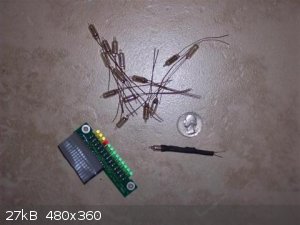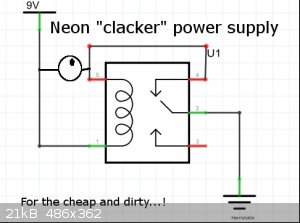alive&kickin
Hazard to Others
  
Posts: 100
Registered: 10-11-2012
Member Is Offline
Mood: No Mood
|
|
miniture neon lamps
Another freebie for the asking. I have some (hundreds) of small neon lamps and a LED bar display (first come first serve on that one). The only real
use I've found for these is a pilot light for any kind of electronic project, although you may have something else in mind. As an example, I used a
current limiting resistor encased in some heatshrink as a power on indicator. Always free. U2U me.

|
|
|
Metacelsus
International Hazard
    
Posts: 2539
Registered: 26-12-2012
Location: Boston, MA
Member Is Offline
Mood: Double, double, toil and trouble
|
|
What striking and sustaining voltage do the neon glow tubes use?
|
|
|
alive&kickin
Hazard to Others
  
Posts: 100
Registered: 10-11-2012
Member Is Offline
Mood: No Mood
|
|
I've used these on circuits from 80 to 120 volt, don't know what the full range is. I can always send enough for a little experimenting.
|
|
|
CharlieA
National Hazard
   
Posts: 646
Registered: 11-8-2015
Location: Missouri, USA
Member Is Offline
Mood: No Mood
|
|
So these samples are available from.....?
|
|
|
Harristotle
Hazard to Others
  
Posts: 138
Registered: 30-10-2011
Location: Tinkerville
Member Is Offline
Mood: I tink therefore I am
|
|
Ah neon lamps, I love 'em.
Great for calibrating spectroscopes,
they have teeny amount of thorium in them, to make them strike (once wasted a summer holiday trying to hack them into cheap geiger tubes).
Not bad for crude, hv static arrestors for a high impedence fet amplifier, put a few in series to make a hv voltage regulator for a geiger tube SB3, 3
buck variety, and a camera flash hacked up and some big resistors.
If you need a cheap 20 gig ohm resistor that runs under 70 volts, well they're good for that too!
Bias one just under striking voltage, lay parallel on a metal or very thin glass plate and it will glow when you bring your finger next to it
(remember the old fashioned lift switches/lights - capacitive touch switch!).
You can even make an oscillator out of a pair of them, if I recall correctly:
+ve
|
o ...................................... neon
|----------|
= ......... o ...................... capacitor neon
|----------|
|
-ve
(please ignore the dots, theyre to make the spacing work in ascii art)
various sizes of resistor can go in series with the neons to extend the time of the flashes.
Or if you are really radical, dip a glowing neon into a molten sodium nitrate salt (or other low temp salt). You will probably get some free
electrons in there, and if done below the melting point of your flint glass envelope, you should after a while get a sodium metal silvering. Remove
neon, make one metal electrode cold by dipping in iced water and the envelope warm, and you should be able to make a sodium metal photocell.
The last is one I haven't tried - it is a modification of Shakashiri's sodium metal electrolysis of of light globe via thermionic emission of
electrons, but I can't see why it wouldn't, given that free electrons and Ne+ ions exist in the evacuated neon lamps.
Have a nice day.
H.
|
|
|
The Volatile Chemist
International Hazard
    
Posts: 1981
Registered: 22-3-2014
Location: 'Stil' in the lab...
Member Is Offline
Mood: Copious
|
|
Harristotle, that's an interesting schematic. I'll have to try it, as I have two tiny neon lamps of my own...
|
|
|
Varmint
Hazard to Others
  
Posts: 264
Registered: 30-5-2013
Location: Near Atlanta, GA
Member Is Offline
Mood: No Mood
|
|
Careful when using these, they exhibit classic negative resistance once struck. That means a series resistor is absolutely required, and that
resistance needs to be quite high, aim for 400 to 500uA.
An interesting experiment is to power it just below the empirically determined strike voltage in a dark area, then shine a red LED at it. The red led
is just enough extra excitement to cause the neon/argon mix in the tube to strike.
|
|
|
The Volatile Chemist
International Hazard
    
Posts: 1981
Registered: 22-3-2014
Location: 'Stil' in the lab...
Member Is Offline
Mood: Copious
|
|
Very interesting. Perhaps a laser pointer would work too, I'll have to try...
|
|
|
alive&kickin
Hazard to Others
  
Posts: 100
Registered: 10-11-2012
Member Is Offline
Mood: No Mood
|
|
CharlieA, these samples are available from.......me. Not quite sure what you mean by that, but it's just a bunch of lamps I've had laying around for
awhile. Available to anyone that wants some. Easy to give away when you have hundreds. Like all I put on here for those in a pinch, free item
including postage. I know a lot of younger people don't have the money to be buying everything they want or need, so why not help them out when
possible.
|
|
|
CharlieA
National Hazard
   
Posts: 646
Registered: 11-8-2015
Location: Missouri, USA
Member Is Offline
Mood: No Mood
|
|
Quote: Originally posted by alive&kickin  | | CharlieA, these samples are available from.......me. Not quite sure what you mean by that, but it's just a bunch of lamps I've had laying around for
awhile. Available to anyone that wants some. Easy to give away when you have hundreds. Like all I put on here for those in a pinch, free item
including postage. I know a lot of younger people don't have the money to be buying everything they want or need, so why not help them out when
possible. |
Thanks for the info. You are certainly generous in helping others out. I was just curious where the neon lamps might come from. I am fortunate that my
brother-in-law is a retired electrical engineer, and loves building stuff. Currently, he is working on a power supply for electrolysis, and an
electronic controller for a cheap toaster oven to convert it into a decent drying oven.
Keep giving others a helping hand. I admire your attitude; it's refreshing.  Charlie
Charlie
|
|
|
alive&kickin
Hazard to Others
  
Posts: 100
Registered: 10-11-2012
Member Is Offline
Mood: No Mood
|
|
CharlieA, if you would like to pass a few on to your brother-in-law, I'd be more than happy to send some your way. I guess that goes for everyone
else, if you know someone else that might want or could use some, let me know.
|
|
|
Texium
Administrator
       
Posts: 4581
Registered: 11-1-2014
Location: Salt Lake City
Member Is Offline
Mood: PhD candidate!
|
|
I received my neon lamps today. Asked for 3, received 12. Very generous! Thank you alive&kickin.
Now I have a sample of neon for the ol' element collection, and a bunch of extra ones to play around with. I haven't tried lighting one up yet though,
as I don't have a safe power supply with that much voltage.
|
|
|
The Volatile Chemist
International Hazard
    
Posts: 1981
Registered: 22-3-2014
Location: 'Stil' in the lab...
Member Is Offline
Mood: Copious
|
|
Quote: Originally posted by zts16  | I received my neon lamps today. Asked for 3, received 12. Very generous! Thank you alive&kickin.
Now I have a sample of neon for the ol' element collection, and a bunch of extra ones to play around with. I haven't tried lighting one up yet though,
as I don't have a safe power supply with that much voltage. |
...Does anybody? My mid-voltage PSU is a Computer PSU with a nice piece of non-insulated Cu wire connected to the proper pins, hooked to two carbon
rods (till my Dad stepped on one....).
|
|
|
IrC
International Hazard
    
Posts: 2710
Registered: 7-3-2005
Location: Eureka
Member Is Offline
Mood: Discovering
|
|
Snap eight 9 volt batteries together in a series string + to - and so on (72 volts) and use in series with around 33 to 100K and the neon lamp. Cap in
parallel with neon to make a relaxation oscillator flasher, vary R and C for speed, brightness, etc., just don't go too low for R. For steady light
without the capacitor figure R to stay below 40 milliwatts or so. Typical neons should light from 55 to 65 volts, lower if built with an internal
radiation source. You can separate a 9 volt snap into 2 halves to easily connect the ends of the battery string. A few more batteries to up the
voltage for increased brightness but calculate all values avoiding going over 2 ma or about that. Overloading the batteries will drop the voltage not
to mention reaching a point where damage to the lamp can occur. In any case you now have a supply that can bite but is much safer, simpler, and
cheaper than building a supply.
"Science is the belief in the ignorance of the experts" Richard Feynman
|
|
|
woelen
Super Administrator
        
Posts: 8014
Registered: 20-8-2005
Location: Netherlands
Member Is Offline
Mood: interested
|
|
A very simple power supply is described here:
http://woelen.homescience.net/science/physics/misc/simple-ps...
Be careful with the thing, especially with the el-cheapo version.
Neon lamps can be used in nice experiments, one can make nice oscillators with them. The power supply, described in the page above, is perfectly
suitable for feeding the oscillator. Read the section about the neon bulb relaxation oscillator:
http://woelen.homescience.net/science/physics/exps/relaxatio...
|
|
|
j_sum1
Administrator
       
Posts: 6321
Registered: 4-10-2014
Location: At home
Member Is Online
Mood: Most of the ducks are in a row
|
|
Neon bulbs arrived yesterday. A dozen of them. They will be good in the element collection.
I intend to get something like this to run them. Will it be suitable?
Thanx so much, alive&kickin!
[Edited on 7-1-2016 by j_sum1]
|
|
|
Harristotle
Hazard to Others
  
Posts: 138
Registered: 30-10-2011
Location: Tinkerville
Member Is Offline
Mood: I tink therefore I am
|
|
Hi J_sum1,
they should work, but use a big resistor 20kohm or better.
Or if you are truly cheap, you can make an old relay clacker and power them from the back emf and a 9v battery ...
Cheers,
H.

|
|
|
The Volatile Chemist
International Hazard
    
Posts: 1981
Registered: 22-3-2014
Location: 'Stil' in the lab...
Member Is Offline
Mood: Copious
|
|
Wow, that's quite a simple circuit! Going to check it out - if my only relay isn't already broken 
|
|
|